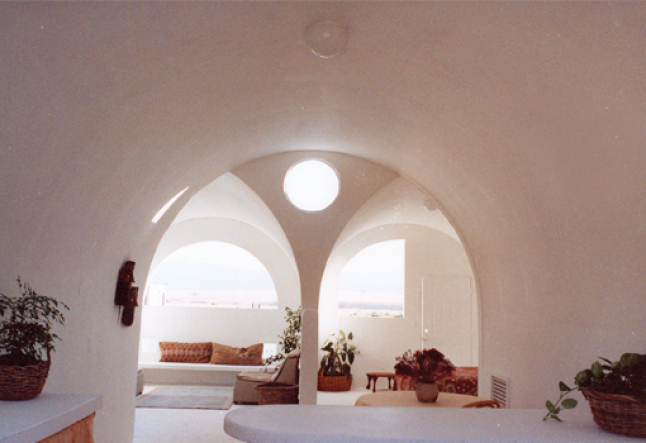earth as our home

natural eco homes
Iranian-born architect and author Nader Khalili was a man who used his brilliant talent not simply for his own gain, but rather to better the world in which we live. His commitment to serving humanity and protecting the environment placed him in a class by himself among his peers.
Founder of Cal-Earth (The California Institute of Earth Art and Architecture), located in Hesperia, CA, Khalili had used this humble nonprofit organization to do everything from create technical innovations published by NASA for lunar base construction to design and development of housing for the homeless on behalf of the United Nations. Khalili received his philosophy and architectural education in Iran, Turkey and the U.S. and has been a licensed architect in California since 1970. Cal-Earth’s philosophy is based on the equilibrium of the natural elements earth, water, air, and fire, and their unity at the service of humanity.
Khalili believed that in order to build structures that provide maximum safety with minimum environmental impact, we must take our example from nature itself, choosing natural materials and designs that maximize space and efficiency in the same manner that we see in nature with beehives and seashells. The strongest structures in nature, which work in tune with gravity, friction, minimum exposure and maximum compression, are arches, domes and vault forms.
Khalili’s building techniques are easily learned and utilize the most available material on the planet: earth. Based on a simple sandbag-and-barbed-wire technology, named Superadobe, each bag layer provides the foundation for the next, with all the earth required found on-site. A great example of this is the ”˜Eco-dome’ design. Learning and building an Eco-Dome is an excellent way to prepare for building a larger design such as the three-bedroom house, because it provides a hands-on learning experience of the essential aspects of Superadobe construction. The Eco-Dome’s size of approximately 400 square feet (interior space) makes it a manageable structure for the first time builder. The finished structure is self-contained and can function as a small guesthouse, studio apartment, yoga studio, bhajan kutir or be the first step in a cluster design or ”˜eco-village’ of vaults and domes.
The basic honeycomb structure can be repeated and joined together forming a larger home and is especially beautiful when designed around an internal courtyard, blurring the line between indoor and outdoor living. In terms of resources, the homes are essentially ”˜tree free’ and can be built by a team of three to five people. Other design factors include sun, shade and wind for passive cooling and heating. A wind-scoop may be combined with a rated furnace unit, depending on local code approval. Of course, solar energy and radiant heating naturally complement the home’s environmental soundness. Furthermore, interior furniture may be built-in with the same earthen material.
Although this is an ancient style of building, San Bernardino County is the first county in America to approve Khalili’s designs. This county is the largest in the U.S., consisting mostly of high and low desert areas, and is arguably one of the least forgiving of terrains. A stock plan is available for an 800-square-foot single-family residence consisting of two joined Eco-Domes. This is a plan that has already been approved, so the builder may receive a permit without additional plan check (in San Bernadino County). Hesperia City has also approved a stock plan of the single Eco-Dome, and the Earth One three-bedroom home.
A 3-Vaulted house prototype developed by Khalili allows maximum space, light, and interior ventilation, while using the traditional form of the vault. The spaciousness of the interior design is derived from three offset vaults allowing a maximum view through the house’s open plan area. This may be combined with domes and apses, or repeated back to back to form a variety of aesthetic and efficiently planned designs. The prototype has been tested and approved for California’s severe earthquake codes and natural elements in the harsh climate of the Mojave Desert, which endures 100+ degree summer temperatures, freezing winters, flash flooding and high speed winds, while holding the distinction of being the highest U.S. earthquake zone (4). The universality of the material and design are one reason NASA scientists are considering them for the moon and Mars in in-situ utilization of planetary resources.
The view through the depth of two vaults increases the sense of interior space, while offset vaults eliminate the need for corridors. The design is based on the repetition of a single vault simplifies construction. Variety can be introduced through the placement of windows and niches. Vaults themselves are inherently beautiful, especially when repeated in a series. The design features many passive energy systems, such as a two-storey wind-scoop that faces prevailing summer breezes. The combination fireplace and wind-scoop enhances both heating and cooling functions. The vaulted curve of the roof, combined with the sun’s path overhead, creates sun and shade zones encouraging circular air movement inside the house, while play of light and shadow minimize the need for decoration.
Additional plan variations start with a one- or two-bedroom house and grow to four or more bedrooms by adding more vaults. Dome elements can be added for a circular living space, a meditation, performance or music room, courtyard, pool, water cistern, root cellar and so on. The environmentally friendly design uses on- or off-site earth with a 99% saving of wood use, in contrast to today’s conventional building systems. There is absolute design flexibility for interior-exterior layout and artistic finishes, and the designs inherently lend themselves to stunning native landscaping.
Nader Khalili embodied the wealth of tradition together with modern day application, but he could not work alone. It requires visionary developers and homebuilders pioneering his designs through the permit stage, creating precedents in counties across the U.S. Only then can his vision of saving the planet, one home at a time, be realized.
Read next >> redondo beach